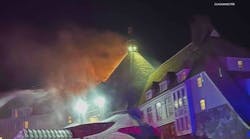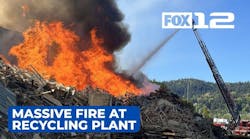In the post-World War II boom, and long before the invention of suburban shopping malls, many workers would stay in downtown areas on Friday evenings, partying much like we do for "happy hours" today. Grover C. Williams, my father, was among the workers who decided on that Friday evening to stay overnight in downtown Atlanta. He and a friend wanted to stay at the Winecoff Hotel but due to a convention, it was full. He and his buddy stayed a block away in the Avon Hotel. Before that fateful night was through, he and many other bystanders would be asked by the Atlanta Fire Department to help hold a life net as victims leaped from the burning Winecoff Hotel.
One man jumped from an upper floor with a baby boy in his arms. The father's head hit the rim of the life net and he was killed. The child survived the fall and was carried by my Dad to a waiting ambulance. The child was rushed to Grady Memorial Hospital and survived the tragedy. Today, he lives in Fort Hays, KS.
Periodically, a reunion of Winecoff survivors is held in Atlanta. On Dec. 4, 1994, the victim and the civilian who carried the little boy away from the building and the nurse who attended to him at the hospital met and had a long chat. Since that time, my father has died, so history will show they met only twice and for short periods of time in both cases. My Dad had not talked much about that night until the Sunday afternoon of the 1994 reunion.
The building still stands in downtown Atlanta and is under renovation to be a hotel again this time with sprinklers and meeting all of the modern code requirements that will make this a much safer building than it has ever been. On Dec. 7, 1996, at 3:42 A.M., a 50th-year memorial service is planned. Apparatus from all the fire departments that fought the fire were invited to attend. The Atlanta Fire Department extends an invitation to you to be a part of this historic event. As was the case 50 years ago, this will be early on a Saturday morning.
The late Deputy Chief Steven B. Campbell was the unofficial historian of the Atlanta Fire Department. This is the story of the Winecoff Hotel fire, written by one who was there and taken from the department's Prompt To Action book of 1960.
The Winecoff Hotel Fire
Saturday, Dec. 7, 1946
The hotel was situated at the southwest corner of Peachtree and Ellis Streets on the highest eminence of downtown Atlanta. It had been built in 1913 by the William A. Fuller Co. of New York. The architect was W.L. Stoddard, also of New York. The cost at the time it was built was in excess of $350,000 and at the time of the fire it had an estimated value of $750,000 to $1 million.
The structure occupies a plot 63 feet by 70 feet at grade, with the main entrance and marquee on Peachtree Street. It was 15 stories (about 155 feet) with a full basement and a small sub-basement. The floors were numbered from one to 16 but, as is the case in many hotels, there was no 13th floor. It had been omitted from the numbering system out of deference to superstition. The top floor was known as the 16th.
The construction classified at the time as "fireproof" included protected steel frame with the roof and floors of concrete on tile filler between protected steel beams and girders. Dividing walls between rooms were of hollow clay tile, plastered on both sides. Exterior walls were 12-inch brick panel type. Doorways typical of the times had "transom" windows over each to assist in ventilation in a hotel prior to air conditioning. These open transoms would spell disaster this night.
The elevator shafts were en-closed in tile with openings on each floor protected by metal doors and wired glass panels. The stairway was not enclosed, a fact that may have been the primary factor in the spread of the fire. The stairway wound around the elevator shaft and was open with no fire doors all the way to the roof penthouse.
The fire was believed to have originated on the third floor from an undetermined cause. Also, there was quite a bit of confusion over the discovery and apparently some delay in transmitting the alarm.
The rapid extension of the fire vertically was mystifying to all the fire experts who conducted the probe and who still express wonderment over the speed with which the fire spread. It may have been the wall coverings which were freshly painted burlap that helped create combustible gases, progressing the intensity of the flames as they traveled upward, and of guests simultaneously throwing open their windows upon the arrival of the first fire companies, which created the necessary draft to speed up the combustion of the flammable gases.
In any event, the heat reached a high degree of intensity which may have been in excess of 1,500 degrees as it melted light bulbs, fused electric ceiling fans, twisted metal doors and cracked porcelain bowls.
The fire department responded on a telephone alarm sounded at 3:42 A.M. under the command of Second Assistant Chief F.J. Bowen and Chief C.C. Styron Sr. (Styron's residence was in the top of Station 1.) Seeing the extent of the fire, immediate rescue operations were begun and fire extinguishing was started on the interior of the building by way of the stairs. The open stairwell kept the flames roaring up-ward moving rapidly and well ahead of the hose crews.
Additional alarms were snapped in rapidly and the final one was the general alarm which brought out the entire fire department and all members of the off-duty platoon. Both volunteer and paid fire departments from the entire metropolitan area of Atlanta heeded the call and mobilized at the scene.
The firefighters were quick to bring into operation all of the aerial ladders of the department and every life net was employed to catch jumping guests. Onlookers were recruited to assist the firefighters in holding the life nets.
Guests were endeavoring to escape the searing flames by improvising escapes with knotted bed sheets and other bed clothes tied together. Many others jumped to their deaths. One struck Fireman A.J. Burnham, injuring him critically. Several of the life nets were demolished after the initial impact of the bodies. Several people leaping at the same time were creating critical safety issues for those holding the nets so this method of rescue had to be abandoned. Several ladder bridges were erected between the burning structure and the adjacent Mortgage Guarantee Building. Some of these were 14 floors off the small alley between the two buildings.
Of the 280 guests and employees in the hotel, 119 were killed and over 100 injured. The fatalities included some of Georgia's most promising high schools students who had come to Atlanta for a YMCA Youth Assembly to be held at the Georgia Capitol on Dec. 7. Also among the dead was W.F. Winecoff, the hotel's original owner, who lived in the building. He lost his life in his room within the "fireproof" hotel that bore his name.
CHRONOLOGY OF ALARMS TRANSMITTED
0304 hours: Telephone alarm Engines 8, 4, 1, 3; Ladders 8, 4, 1; Rescue 1; Light Truck 1; Chief of Department C.C. Styron Sr. and Second Assistant Chief F.J. Bowen.
0344: Second alarm Engines 5, 6, 11, 15; Ladders 5, 11 , 21.
0349: Third alarm Engines 9, 12; Ladders 7, 12.
0402: General alarm Engines 2, 7, 10, 13 ,14, 16, 17, 18, 19, 20, 21, 22, 21; Ladders 10, 16, 19; Battalion Chiefs W.A. Fain and J.G. Webb.
0405: Mutual aid for all available fire departments and firefighters as listed above.
A complete account of the Winecoff Hotel fire and its aftermath is provided in the book, The Winecoff Fire: The Untold Story Of America's Deadliest Hotel Fire, by Sam Heys and Allen B. Goodwin (Longstreet Press, Atlanta, $19.95).
Dave E. Williams, a Firehouse® correspondent, is a senior account engineer with Allendale Mutual Insurance Company of the Factory Mutual System, based in Atlanta. He is a member of the Metropolitan Fire Association of Atlanta, the International Association of Fire Chiefs (IAFC) and the Georgia Association of Fire Chiefs and Firefighters.








